MO Tested: Cambox MkV4 Pro Action Camera

An ingenious take on action cameras.
The whole point of an action camera is to put the viewer in your seat. In our case, it’s to bring the viewer along for a ride with us and to see all the things we see in the moment. From close passes to stunning scenery, recording your ride allows you to relive those special moments over and over again. Not to mention it gives you proof when your friends say video or it didn’t happen.
Mounting a camera to the side of the helmet gets us pretty close, but it’s not quite the same angle or perspective. The chin mount is a popular alternative, too, and while this gets us pretty close to having the same views, it’s not quite the same. With the Cambox MkV4 Pro, the viewer gets to see things just as you do because of the genius mounting location – right above eyebrow level.
What?! Tell Me More
Unlike basically all other action cameras on the market, the Cambox MkV4 Pro is not a small rectangular box with a lens attached. Instead, its thin plastic housing is shaped to match the curvature of your forehead, and the included velcro strips allow it to attach to the top of your helmet’s eyeport. The lens is in the middle, thus giving the viewer almost exactly the same view that you have.
If you’re not familiar with Cambox, the French company makes all kinds of similar cameras for equestrian and action sports. The early days involved mounting the cameras to the underside of the helmet visors horse jockeys would wear. Of course, seeing the footage of a live animal underneath the jockey bucking, turning, running, jumping, and otherwise doing all the elegant things horses do, the idea quickly grew legs, since it’s fairly obvious a camera like this would be popular for tons of helmet-wearing athletes.
Fast-forward a few years and a few prior iterations and we come to this, Version 4. There are three iterations of the V4 – V4, MkV4+, and the MkV4 Pro. The highest in the Cambox Meca (the motorsports division) range is the one we have here, the MkV4 Pro. Able to shoot in 4K quality in 60 frames per second (as well as 1080p at 240 fps), it also features ultra-smooth electronic image stabilization, a 150º field of view, wifi compatibility, a dedicated Cambox app, and the ability to record up to 45 minutes in 4K quality. It records to a micro SD card up to 128gb.
The lens itself has the ability to rotate 20º up or down, meaning you’re able to get just the right angle no matter what kind of motorcycle you’re riding. And because you simply attach the velcro strips to the camera and to the top of your eye port in your helmet, installation couldn’t be easier. The result? Well, see for yourself:
Not bad, wouldn’t you agree?
Some Things I Like
The biggest thing the Cambox Meca has going for it is how easy it is to install and use, hence why it’s my go-to camera when I want to capture on-board footage. Not to mention the POV puts you, the viewer, right there with me when I’m riding.
Actually operating the camera takes some getting used to, as the only indicators you get are via LED lights and a certain sequence of vibrations. There are two buttons on the body, one big, one little. The main button (the big one) turns the camera on and starts recording. Turning it on requires a long button press until a white light appears beside the button. Then a simple tap turns the light green, a short series of buzzes follows, and you’re recording. Another tap stops recording and the light turns white again. It’s really quite simple. Alternatively, you can pair the camera to the smartphone app, frame your shot, and press record from the app. The other button activates the camera’s wifi, but more on that later.
Microphones internally placed on each side of the Cambox record in stereo quality, and you can go into the app and decide one of four options – high, medium, low, or off – in regards to microphone sensitivity. For motorsports, I set it to low to minimize the amount of wind noise coming through.
As for video quality, well, you can judge for yourself from the video above. I’d say it’s quite good. Also consider the bumps and jolts you experience from the saddle. The Cambox’s electronic image stabilization dampens a lot of those vibes and gives a really smooth video, in my opinion.
What I Don’t Like
Before getting too deep into this section, it’s important to remember this has become my go-to camera when I’m trying to capture on-board footage. For as great as the heralded GoPro is, the Cambox Meca is on another level when it comes to convenience paired with video quality.
However, we’re all familiar with GoPro and the video quality it can record in. It’s incredible. The Cambox Meca MkV4, while able to shoot in 4K, never quite looks as sharp as what comes out of the GoPro. There’s an important caveat to keep in mind with the Cambox, though – because it’s placed inside the helmet, it’s recording through your visor. If you wear a tinted shield like I do most of the time, the video is automatically a shade darker (kids these days call that a filter, but we know better). Keep in mind that, over the course of a ride, your shield will naturally get dirty. All of the dirt, grime, and bug guts that show up on your visor will also show up on your video and could lower the quality of your video. So shield cleanliness is ultra important with the Cambox.
Nonetheless, even with the shield open and the camera able to record natural light, colors don’t appear to pop as brightly as with the GoPro and images aren’t quite as crisp. It’s a fair tradeoff to make in my opinion, but others may feel differently.
Also, while you’re able to tune the microphone sensitivity, even in its lowest setting, you saw – or rather heard for yourself in the video above – how distracting the wind noise can be at high speed. Once you get into the triple digits then it really becomes bad. Depending on the bike and the amount of wind protection you have, exhaust notes are still audible, but there’s a lot of wind mixed in. Take wind noise out of the equation and you have cool clips like the one below, courtesy of former F1 driver turned Indycar star Romain Grosjean:
While we’re on the topic of microphones, unlike the ubiquitous GoPro, the CamBox doesn’t have an external microphone jack to plug in, meaning trying to record a running commentary while riding is virtually impossible. For those of you who’d rather not hear our voices while riding, this may not be a negative after all…
With a battery life of about 45 minutes when shooting in 4K (if you’re lucky), you can burn through that very fast on a street ride. Since the battery is internal and non-removable, you can’t replace it quickly like with a GoPro. For track riding, I’ve gotten into the habit of keeping a spare USB-C cord with me and plugging it in to recharge between sessions. However, if the camera overheats – which occasionally happens when continually recording on hot days – it can freeze. The only way to reset it is to let the battery drain, plug it in, and turn it on again.
A minor inconvenience, but the eyebrow vents on Arai helmets means there’s less of a flat surface at the top of the eyeport to secure the velcro to. This means there are less contact points to attach the Cambox. So far this hasn’t been a problem, but psychologically it could weigh on the back of some people’s minds.
And finally, the app. If you’re an Android user like I am, it’s really only good for framing your shot and pressing record. Granted, the app is under constant development and the Cambox team is a fraction of the army GoPro has employed, but viewing the gallery from the app on my Android phone is not possible. Which means sharing anything onto social media directly from the app isn’t possible, either. Instead I have to download a clip to my computer, edit it to my liking, then do with it what I want. Frankly, I just don’t have the time or enthusiasm for those extra steps.
Final Verdict
Overall, the Cambox Meca MkV4 Pro does most of the work I would normally use a GoPro for, and is much more convenient. Because it’s inside my helmet, riding photos don’t show a bulbous camera sticking off the side or front of my helmet (an annoyance only petty motojournos have to deal with, I know…).
Speaking of photos, the MkV4 can also be placed in photo mode much like the GoPro, though this is a feature I’ve never really found the need for in either camera, opting instead to grab a freeze frame from the video. As of this writing, slow motion and time lapse video are new features available within the app, but as mentioned above, Android users are still hosed in that regard.
Starting at $475, the Cambox Meca MkV4 Pro is roughly on par with GoPro pricing. As an owner of both, I find myself reaching for the GoPro primarily if I’m looking for shots at different angles the Cambox simply can’t get. Otherwise, when it comes to onboard riding footage, the quality and convenience of the MkV4 Pro can’t be beat.
FAQ
What is the best action camera?
This is a loaded question, but the answer depends on what you’re trying to do (somewhat). When it comes to the infrastructure built around it, GoPro has a stranglehold on the market similar to the way Apple does with phones. However other companies, like Cambox, offer something unique. In this case, the Cambox cameras mount inside your helmet to give as close to the same view as you’re seeing, all while exposing nothing to the outside of the helmet.
How to mount a camera on a helmet?
You don’t have to mount anything on the helmet if you opt for one of the Cambox cameras. However, for the majority who use a GoPro, mounting is as simple as taking a mounting plate, peeling away cover to expose the adhesive, sticking it to your desired location, and using assorted accessories to mount the camera to the plate.
Related Reading
MO Tested: Sena Prism Tube Action Camera Review
MO Tested: Innovv C5 Motorcycle Camera System Review
MO Tested: Insta360 OneX Camera Review
MO Tested: INNOVV K2 Motorcycle Camera System Review
We are committed to finding, researching, and recommending the best products. We earn commissions from purchases you make using the retail links in our product reviews. Learn more about how this works.
Become a Motorcycle.com insider. Get the latest motorcycle news first by subscribing to our newsletter here.

Troy's been riding motorcycles and writing about them since 2006, getting his start at Rider Magazine. From there, he moved to Sport Rider Magazine before finally landing at Motorcycle.com in 2011. A lifelong gearhead who didn't fully immerse himself in motorcycles until his teenage years, Troy's interests have always been in technology, performance, and going fast. Naturally, racing was the perfect avenue to combine all three. Troy has been racing nearly as long as he's been riding and has competed at the AMA national level. He's also won multiple club races throughout the country, culminating in a Utah Sport Bike Association championship in 2011. He has been invited as a guest instructor for the Yamaha Champions Riding School, and when he's not out riding, he's either wrenching on bikes or watching MotoGP.
More by Troy Siahaan












































Comments
Join the conversation
Great review, I love the sleek integration of this camera system! I'm now considering one for my daily commute. My questions are:
1. Does this block forward vision if you are in a full, head-down tuck?
2. Without adjusting the camera direction mid-ride, can this successfully capture both sitting up riding position and full lean tuck without being either video of the sky or video of your tank?
3. Would this be less-safe in the event of a crash compared to an externally mounted camera?
Just wanted to add that the cambox is NOT waterproof and the battery life is terrible, you'll be lucky to get an hours use out of it. Cambox state on their website Waterproofing - Showerproof (resists to water splashes, rain and snow only). I contacted cambox for advice on how to extend the battery life, they suggested purchasing an external battery pack and a flat USB cable to be able to then close the lid. Although they did say the following: Not that the camera would suffer from the rain but more for safety reasons when the case lid is dangling. I thought this a bit odd so purchased the flat cable just to be on the safe side. We thought all was good until we went to review some video footage and found that a lot of the files were 0 bytes. Sent the cambox back to them, after investigation they said that it had water damage so it was not covered under warranty. They also said that they understood my concerns regarding the location of the water damage on the circuit board and that the Cambox may not always be positioned flat when mounted on a helmet, which can lead to water migrating and causing damage in unexpected areas (It would have been good to have know this beforehand). The repair bill was basically half the price of a GoPro so I declined the repair and said that I would put the money towards a GoPro instead I then never heard back from them. I then left a TrustPilot review which prompted Cambox to get in touch, in the end they knocked 50% off the repair bill but again I declined as I thought it better to put the money towards a GoPro as I'm sure that will be okay in the rain as you can take it underwater. Please check the TrustPilot reviews before buying one of these cameras and don't be tempted by how good it looks and the concept like I was. Just purchase a GoPro to start with and a chesty mount.